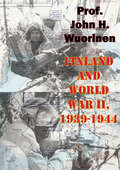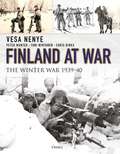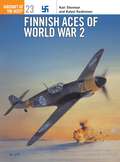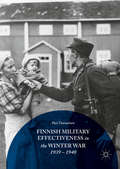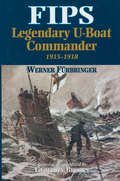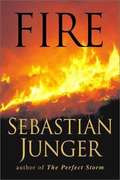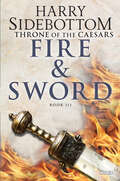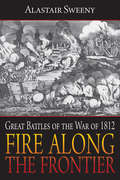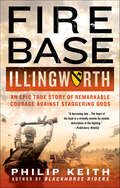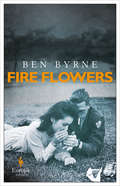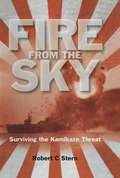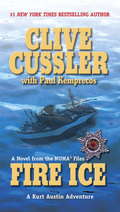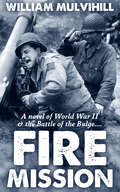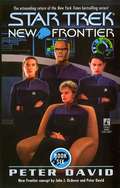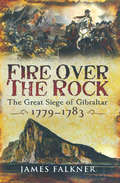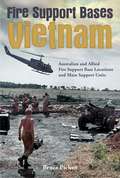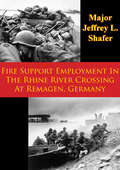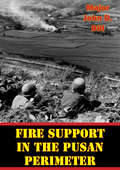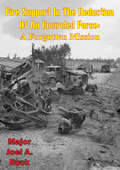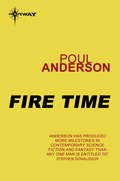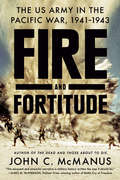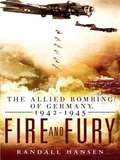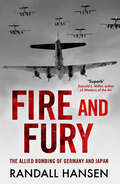- Table View
- List View
Finland And World War II, 1939-1944
by Prof. John H. WuorinenFinland gained its independence from Russia in 1917 during the turmoil of the Russian Civil War, and ever since the communist leaders cast envious eyes toward their former domain; only waiting for a chance to invade. With the rise of Hitler's Germany the face of Europe changed, agreements were reached between the Soviets and the Nazis in brutally dividing up a nigh-defenceless and the detente culminated in the Non-Aggression Pact of 1939. This gave Stalin and his cohorts a chance to expand their borders, whilst Hitler looked west at France and Britain, by launching an attack directed to recapture their former Grand Duchy. Thus started Finland's participation in the Second World War. This book eloquently recounts the stubborn resistance of the Finns against the Soviet attack during the Winter War, the horrific siege of Leningrad and the Finns brave bid to retain its independence from Soviet dominance. The manuscript for the book was smuggled out of Soviet controlled Finland in late 1945, it was passed to Professor Wuorinen who skilfully edited and annotated the work into its present form.A fascinating sidelight on a little known corner of the brutal Second World War.
Finland at War 1939-45
by Raffaele Ruggeri Philip JowettIn the face of Soviet invasion in 1939-40, and once again in 1941-44, the armies raised by Finland - a tiny nation of only 4 million people - astonished the world by their effective resistance. At the end of both these campaigns - the Winter War, and the Continuation War - the fiercely patriotic defiance of vastly stronger Soviet forces by Marshal Mannerheim's soldiers won their country a unique prize: although forced to accept harsh terms, Finland was never occupied by the Red Army, and retained its independence. This book explains and illustrates, for the first time in English, the organization, uniforms, equipment and tactics of Finland's defenders.
Finland at War: The Winter War 1939-40
by Vesa NenyeThe story of the 'Winter War' between Finland and Soviet Russia is a dramatic David versus Goliath encounter. When close to half a million Soviet troops poured into Finland in 1939 it was expected that Finnish defences would collapse in a matter of weeks. But they held firm. The Finns not only survived the initial attacks but succeeded in inflicting devastating casualties before superior Russian numbers eventually forced a peace settlement. This is a rigorously detailed and utterly compelling guide to Finland's vital, but almost forgotten role in the cataclysmic World War II. It reveals the untold story of iron determination, unparalleled skill and utter mastery of winter warfare that characterized Finland's fight for survival on the hellish Eastern Front. Finland at War: the Winter War 1939-40 is the premiere English-language history of the fighting performance of the Finns, drawing on first-hand accounts and previously unpublished photographs to explain just how they were able to perform military feats that nearly defy belief.
Finnish Aces of World War 2
by Kari StenmanAlways outnumbered by their Soviet counterparts, the small band of Finnish fighter pilots who defended their Scandinavian homeland from the 'communist hordes' in three separate wars between 1939 and 1945 amassed scores only bettered by the Luftwaffe's Jagdflieger. Initially equipped with a motley collection of biplane and monoplane fighters garnered from sources across the globe, the Finnish Air Force was thrust into combat in November 1939. Given little chance against the massive Soviet force, the Finnish fighter pilots confounded the sceptics and decimated the attacking fighter and bomber formations, prompting the Russians to call a halt in March 1940. This scenario was repeated in 1941, and by 1943 the Finns had become uneasy allies with the Germans. Complete with first-hand accounts and detailed colour illustrations, this book profiles aces like Juutilainen and Wind, who proved unbeatable in the final months of conflict.
Finnish Military Effectiveness in the Winter War, 1939-1940
by Pasi TuunainenThis book analyzes the multi-faceted phenomenon of Finnish military effectiveness in the Winter War (1939-40). Drawing on a wide array of primary and secondary sources, Pasi Tuunainen shows how by focusing on their own strengths and pitting these against the weaknesses of their adversary, the Finns were able to inflict heavy casualties on the Red Army whilst minimizing their own losses. The Finns were able to use their resources for effective operational purposes, and perform almost to their full potential. The Finnish small-unit tactics utilized the terrain and Arctic conditions for which they had prepared themselves, as well as forming cohesive units of well-motivated and qualitatively better professional leaders and citizen soldiers who could innovate and adapt. The Finnish Army had highly effective logistics, support and supply systems that kept the troops fighting.
Fips: Legendary U-Boat Commander, 1915–1918
by Geoffrey Brooks Werner FürbringerWeuner Frbringer (Fips) became one of the most successful U-Boat commanders in WW1 through a blend of skill, daring and, by his own typically modest admission, sheer luck. This vivid memoir, never before published in English, makes compelling reading.This is an inspiring and chivalrous story; it is ironic then that, when finally sunk by the Royal Navy off the East Coast of England, Fips was machine-gunned in the water, contrary to repeated Government denials of such behaviour.
Fire
by Sebastian JungerSebastian Junger details his first-hand experiences as he describes fire fighting. As a seasoned journalist he travels the world and brings the reader face to face with many crises.
Fire & Sword: Book Three (Throne of Caesars) (Throne of the Caesars #3)
by Harry SidebottomAncient Rome’s Emperor Maximinus faces wars and uprisings in this tale of political intrigue from the bestselling author of the Warrior of Rome novels.Blending heart-pounding action and historical accuracy, Harry Sidebottom’s bestselling Warrior of Rome series took readers from the shouts of the battlefield to the whisperings of the emperor’s inner circle. In this second book of his new Throne of the Caesars series, Sidebottom continues his retelling of one of the bloodiest periods of Roman history—the Year of the Six Emperors. In Rome in the year 238 AD, Emperor Maximinus’s reign hangs in the balance. The empire is bleeding manpower and money in order to sustain its wars in the north, and rebellions flare in the far reaches of its territories. Meanwhile in Africa, Gordian the Elder and Younger are proclaimed as the new Augusti. A family descending from the Imperial bloodline, they represent a chance for the establishment to take back the empire. The first blood of the revolt is shed in Rome when an assassin murders the emperor’s prefect, announcing to Rome that the Gordians have taken the throne; still bitter at Maximinus’s rise from the barracks to power, the Senate endorses the rebellion, and chaos descends on the capitol. But in his heart, Maximinus is a man of war: when he hears of the betrayal, he acts with decisive brutality and violence. On the dusty plains outside Carthage, blood and steel will determine the fate of the Roman Empire . . . Praise for Blood & Steel“Swashbuckling as well as bloody, yet curiously plausible . . . Best of all [Sidebottom] has a real gift for summoning up a sense of place, and conveying the sheer vastness of the Roman empire and its implications.” —Times Literary Supplement“Sidebottom continues his “Throne of the Caesars” series . . . with his new novel, Blood & Steel, and reading the intense drama he crafts out of the tumultuous events of the Roman Empire in AD 238 is a reminder that we’re lucky to have these books. . . . This is an era of Roman history for which we have less reliable primary source histories than we’d like; it’s the perfect playground for a novelist, and it’s found a superb dramatist.” —Open Letters Monthly
Fire Along the Frontier: Great Battles of the War of 1812
by Alastair SweenyA view of the War of 1812 from a social perspective. This book provides a fresh new view of the battles of the war and goes behind the scenes to explore wartime trading activity, particularly American dealings with Napoleon and cross-border commerce, as well as the activities of John Jacob Astor, America’s richest man and war financier, and his fur-trading partners in Montreal.There was a wealth of military screw-ups. What did the generals do before each battle to lose it, and what could they have done to win? And did the incompetence and mixed loyalties of Military Governor Sir George Prevost, grandson of a financier of the American Revolution and nephew by marriage of Vice President Aaron Burr, nearly lose Canada for the British?The book also provides glimpses of some of the fascinating behind-the-scenes players, such as legendary but flawed President Thomas Jefferson, and President Madison’s wife, Dolley, who could have won the war single-handedly had she been able to get all the generals together in the same drawing room.
Fire Base Illingworth: An Epic True Story of Remarkable Courage Against Staggering Odds
by Philip Keith“[A] propulsive history of American soldiers under siege in the last days of the Vietnam War” from the award-winning author of Blackhorse Riders (Kirkus Reviews).In the early morning hours of April 1, 1970, more than four hundred North Vietnamese soldiers charged out into the open and tried to over-run FSB Illingworth. The battle went on, mostly in the dark, for hours. Exposed ammunition canisters were hit and blew up, causing a thunderous explosion inside the FSB that left dust so thick it jammed the hand-held weapons of the GIs. Much of the combat was hand-to-hand. In all, twenty-four Americans lost their lives and another fifty-four were wounded. Nearly one hundred enemy bodies were recovered. It was one of the most vicious small unit firefights in the history of US forces in Vietnam.As in his acclaimed book Blackhorse Riders, a finalist for the prestigious Colby Award, Phil Keith uncovers a harrowing true story of bravery and sacrifice by the men who fought valiantly to hold FSB Illingworth—a tale never-before-told and one that will not be soon forgotten."A harrowing tale that centers on an exhausted, ragtag group of U.S. Army troops as they fought for their lives against a 400-man North Vietnamese Army regiment in a vicious engagement in 1970 . . . The heart of the book is a virtually minute-by-minute description of the fighting." —Publishers Weekly
Fire Flowers
by Ben ByrneIn this &“promising literary debut,&” three Japanese citizens and one American reporter rebuild their lives in the aftermath of Japan&’s WWII surrender (The Independent). Japan, 1945. The country has just surrendered to the Allied forces after suffering the devastation of nuclear warfare. Satsuko Takara and her teenage brother, Hiroshi, have lost both their parents, and each other, during the firestorm that devastated Tokyo five months before. Documenting the destruction of the war is Hal Lynch, a haunted US photojournalist, who stumbles upon a shocking story and is determined to bring it to light. And Osamu Maruki, a dissolute writer and once Satsuko&’s lover, has returned from the South Pacific a broken and changed man. The war-torn streets of Tokyo come alive in this dazzlingly observed debut novel as the lives of these former enemies come together. Fire Flowers powerfully portrays the shock, the struggles, and the difficult choices that arise from the destruction of war. &“An impressive and nuanced account of a dark moment in history.&” —The Independent
Fire From the Sky: Surviving the Kamikaze Threat
by Robert C. StemBy late 1944 the war in the Pacific had turned decisively against the Japanese, and overwhelming Allied forces began to close in on the home islands. At this point Japan unveiled a terrifying new tactic: the suicide attack, or Kamikaze, named after the Divine Wind which had once before, in medieval times, saved Japan from invasion. Intentionally crashing bomb-laden aircraft into Allied warships, these piloted guided missiles at first seemed unstoppable, calling into question the naval strategy on which the whole war effort was based.This book looks at the origins of the campaign, at its strategic goals, the organization of the Japanese special attack forces, and the culture that made suicide not just acceptable, but honourable. Inevitably, much mythology has grown up around the subject, and the book attempts to sort the wheat from the chaff. One story that does stand up is the reported massive stock-piling of kamikaze aircraft for use against any Allied invasion of the home islands, if the atomic bombs had not forced Japans surrender.However, its principal focus is on the experience of those in the Allied fleets on the receiving end of this peculiarly alien and unnerving weapon how they learnt to endure and eventually counter a threat whose potential was over-estimated, by both sides. In this respect, it has a very modern resonance.
Fire Ice (NUMA Files #3)
by Clive Cussler Paul KemprecosIn his novels Serpent and Blue Gold, #1 bestselling author Clive Cussler introduced a hero for the new millennium: Kurt Austin, the leader of NUMA's Special Assignment Team, and an instant hit with critics and fans. Tulsa World said, "As always, Cussler twists fact and fiction into a rope of tension that will leave you dangling until the last page."<P> Now Kurt Austin returns to tackle his most dangerous mission to date... In the heart of the old Soviet Union, a mining tycoon is determined to overthrow the Russian government-distracting the U. S. with a man-made natural disaster using a notoriously unstable compound known as "fire ice." Detonation of this compound could create a tidal wave big enough to destroy a major city. But Kurt Austin and his Special Assignment Team are about to make a few waves of their own....
Fire Mission
by William MulvihillFire Mission, first published in 1957, is a fictional account of a field artillery battery beginning just before the Battle of the Bulge (December 1944), to the capture of the bridge at Remagen in March, 1945. As the author served in an artillery battery during the Battle of the Bulge, his writing accurately portrays the lives of the soldiers living through the cold, filth, and death of this epic battle near the end of the war. William Mulvihill would later write the best-selling novel, The Sands of Kalahari, made into a motion picture in 1965.
Fire On High (Star Trek: The Next Generation #6)
by Peter DavidA thrilling Star Trek: The Next Generation novel featuring the crew of the USS Excalibur.Lieutenant Robin Lefler&’s mother died in a shuttle explosion ten years ago. So is the woman being held prisoner in Thallonian space really her? If it is, what is her connection to the mysterious woman holding a weapon that could doom entire worlds? With the lives of billions at stake, Robin Lefler, Captain Calhoun and the crew of the USS Excalibur must find the answers before time runs out for them and for the struggling remnants of the once-great Thallonian Empire.
Fire Over the Rock: The Great Siege of Gibraltar, 1779–1783
by James Falkner&“This book does a wonderful job in describing a portion of [the Rock of Gibraltar&’s] history during the Napoleonic Wars&” (The Past in Review). The great siege of Gibraltar was the longest recorded in the annals of the British army. Between 1779 and 1783, a small British force defended the Rock against the Spanish and the French who were determined take this strategically vital point guarding the entrance to the Mediterranean. The tenacity and endurance shown by the attackers and defenders alike, and the sheer ingenuity of the siege operations mounted by both sides, make the episode an epic of military history, and the story gives us a fascinating insight into the realities of siege warfare. In this, the first full study of the siege for over forty years, James Falkner draws on a wide range of contemporary sources to tell the exciting tale of a huge and complex operation.
Fire Support Bases Vietnam: Australian and Allied Fire Support Base Locations and Main Support Units
by Bruce PickenFire Support Bases Vietnam is a meticulous documentation of the construction, location and role of fire support bases during the Vietnam War, compiled by Vietnam veteran Bruce Picken. Often makeshift bases hacked out of primary jungle, these artillery gun areas provided essential support to infantry field units during operations in South Vietnam. In its simplest sense, a fire support base was an often hastily constructed fortified artillery base position, usually sited forward close to the centre of the area of operations in support of task force, battalion or company operations. The role of the fire support base was to bring artillery and mortar fire within range of friendly forces operating in depth. Artillery gun areas were not unique to the Vietnam conflict. In previous wars they were deployed in allied territory to cover the front lines and to support advancing troops. The concept was first applied in Vietnam by US forces and quickly adapted by Australian forces arriving in Phuoc Tuy Province in May 1966 to fight a new kind of war. This conflict was not like its predecessors and the fire support bases were now more usually sited in territory dominated by the enemy to provide much-needed protection for forces operating in bitterly contested areas. Fire Support Bases Vietnam is a detailed account that identifies every fire support base by date, location and role and provides an outline of the operations in which they participated. This is an essential reference book for those with a serious interest in the Vietnam War, and adds valuable detail to the study of a campaign that occupies a unique place in the Australian psyche.
Fire Support Employment In The Rhine River Crossing At Remagen, Germany
by Major Jeffrey L. ShaferThis study is an historical analysis of the procedures and doctrine used by the III Corps Artillery during the First U.S. Army's crossing of the Rhine River at Remagen, Germany. This study examines the actions of III Corps Artillery in the employment, organization for combat, and command and control of artillery units at Remagen. The fire support procedures employed by the field artillery are compared with those prescribed by published doctrine and unit standing operating procedures. This comparison is used to evaluate the adequacy of doctrine and the need for standing operating procedures to supplement the published doctrine. The development of standing operating procedures from lessons learned during earlier combat is examined to show how the doctrine allowed flexibility and standardization that was evident throughout the army. This standardization continues to serve as a model for fire support operations in today's emerging combined arms doctrine.The study concludes with lessons learned: (1) Centralized command and control of field artillery should be under the headquarters that is best organized to control a large number or units, (2) doctrine and standing operating procedures are useless unless leaders develop and execute plans that are in accordance with the principles established and practiced, (3) the tendency to establish standing operating procedures that violate or contradict doctrine should be avoided, (4) a need for more liaison officers was evident at Remagen as well as through the war and continues to exist today even with improved technology, (5) the redundancy of tasks outlined in doctrine provides the flexibility needed to accomplish the fire support mission during a fast moving battle, and (6) field artillery units should practice several tactical missions and not just the standard mission associated with peace time organizations.
Fire Support In The Pusan Perimeter
by Major John D. DillFive years after emerging victorious from World War II, the United States became embroiled in the Korean War. In August of 1950, despite the relative industrial and technological disadvantages suffered by the enemy North Korean Peoples' Army, the American Eighth Army was nearly defeated and pushed into the sea while trying to defend a toehold on the Korean peninsula around the port of Pusan. The poorly trained and equipped U.S. soldiers and marines defending the Pusan Perimeter relied heavily on fire support assets to stem the tide and defeat the North Korean attack.This monograph asks if the fire support, including both artillery and air fires, provided to the Eighth Army Infantry and Armor units was effective. It also examines the reasons for the success or failures of fire support by contrasting the use of fire support by different Army and Marine Corps units as they defended the perimeter. Additionally, the monograph addresses the question of how the force development process shaped the success or failure of the Pusan fire support effort. Finally, the monograph discusses lessons from the Pusan defense that are applicable to current fire support and force development.The monograph concludes that the fire support effort in the Pusan campaign was effective. However, because of the force reductions and training lapses that occurred after World War II in the United States Army and Air Force, it was not as effective as it could have been. The time taken to relearn the lessons of World War II and to rebuild units to doctrinal war time strength needlessly cost lives. The Pusan perimeter fight contains valuable lessons for current fire support leaders as they grapple with challenges similar to those faced by their predecessors in the summer of 1950.
Fire Support in the Reduction of an Encircled Force - a Forgotten Mission
by Major Joel A. BuckUsing historical analysis and survey, this study examines the sufficiency of U.S. field artillery doctrine, tactics, and techniques to support the destruction of an encircled enemy. Focus is on identifying existing weaknesses by comparing applicable lessons learned from history with the practices spelled out in current manuals. The Allied attempt to encircle and reduce the German forces within the Falaise-Argentan pocket in central France during August 1944 and the Soviet Belorussian Offensive and subsequent encirclement and reduction of German forces during June 1944 are examined. The results of a survey completed by the V and VII U.S. Corps artillery commanders on the subject are also included.Among the shortfalls identified are: current attention is more focused on breaking out of an encirclement than on forming an encirclement; when encircling an enemy is addressed, discussion stops after the encirclement is formed and before reduction begins; field artillery procedures do not separately address this mission; friendly or enemy use of chemical or nuclear weapons has not been considered; the requirement to simultaneously support reduction and exploitation operations has not been addressed; there is a need for an artillery commander at echelons above corps.The study concludes that the process of reducing a large encircled enemy force is sufficiently different from other operations that it should be separately addressed. Although the "doing" of the component parts of the artillery aspect of this operation are doctrinally established, tying them together into a synergetic package requires innovative attention. Resulting field artillery doctrine, tactics, and techniques derived are equally applicable in reducing an isolated enemy force that has broken through or been Inserted Into our rear area as they are in the reduction of an offensively encircled enemy.
Fire Time
by Poul AndersonAnu, red giant companion-star to Bel and Ea, was relentlessly approaching Ishtar - scorching the land, forcing the barbarians of the North ever southward away from the Inferno. Fire Time was fast confronting the planet; civil war broke out as the Tassui led their forces against the army of the Gathering in a desperate struggle for survival.The Gathering anxiously awaited help from the human colony in Primavera. Jill Conway and other colonists like her hoped to save the civilisation of Ishtar and they relied on the Navy of the Federation of Earth to do so. But now the Federation was engaged in its own was, an interstellar war that seemingly had no end. And no end meant no help of Ishtar...
Fire Wind (Executioner, # #279)
by Don PendletonDEATH CLAUSE A black ops project has gone rogue, sending Mack Bolan into the world of shadow players and classified games as traitors in high places prepare to sell out America to terrorism and mass murder. In a mission where everyone has something to hide, Bolan goes hunting for the worst kind of savage: those sworn to protect the U.S. government. Facing off against the mercinary force recruited by the hellish high-tech conspiracy, Bolan makes his own rules. But as the boundaries of the killing game close in, he finds himself caught in a conflagration of death and corruption - and betrayed by the home team. If this mission calls for the final sacrifice, the Executioner won't be going alone.
Fire and Fortitude: The US Army in the Pacific War, 1941-1943
by John C. McManusAn engrossing, epic history of the US Army in the Pacific War, from the acclaimed author of The Dead and Those About to Die“This eloquent and powerful narrative is military history written the way it should be.”—James M. McPherson, Pulitzer Prize-winning historian "Out here, mention is seldom seen of the achievements of the Army ground troops," wrote one officer in the fall of 1943, "whereas the Marines are blown up to the skies." Even today, the Marines are celebrated as the victors of the Pacific, a reflection of a well-deserved reputation for valor. Yet the majority of fighting and dying in the war against Japan was done not by Marines but by unsung Army soldiers. John C. McManus, one of our most highly acclaimed historians of World War II, takes readers from Pearl Harbor—a rude awakening for a military woefully unprepared for war—to Makin, a sliver of coral reef where the Army was tested against the increasingly desperate Japanese. In between were nearly two years of punishing combat as the Army transformed, at times unsteadily, from an undertrained garrison force into an unstoppable juggernaut, and America evolved from an inward-looking nation into a global superpower. At the pinnacle of this richly told story are the generals: Douglas MacArthur, a military autocrat driven by his dysfunctional lust for fame and power; Robert Eichelberger, perhaps the greatest commander in the theater yet consigned to obscurity by MacArthur's jealousy; "Vinegar Joe" Stillwell, a prickly soldier miscast in a diplomat's role; and Walter Krueger, a German-born officer who came to lead the largest American ground force in the Pacific. Enriching the narrative are the voices of men otherwise lost to history: the uncelebrated Army grunts who endured stifling temperatures, apocalyptic tropical storms, rampant malaria and other diseases, as well as a fanatical enemy bent on total destruction. This is an essential, ambitious book, the first of two volumes, a compellingly written and boldly revisionist account of a war that reshaped the American military and the globe and continues to resonate today.
Fire and Fury
by Randall HansenNational Bestseller An enlightening and utterly convincing re-examination of the allied aerial bombing campaign and of civilian German suffering during World War II–an essential addition to our understanding of world history. During the Second World War, Allied air forces dropped nearly two million tons of bombs on Germany, destroying some 60 cities, killing more than half a million German citizens, and leaving 80,000 pilots dead. Much of the bombing was carried out against the expressed demands of the Allied military leadership. Hundreds of thousands of people died needlessly. Focusing on the crucial period from 1942 to 1945, and using a compelling narrative approach, Fire and Fury tells the story of the American and British bombing campaign through the eyes of those involved: military and civilian command in America, Britain, and Germany, aircrew in the sky, and civilians on the ground. Acclaimed historian Randall Hansen shows that the Commander-in-Chief of Bomber Command, Arthur Harris, was wedded to an outdated strategy whose success had never been proven; how area bombing not only failed to win the war, it probably prolonged it; and that the US campaign, which was driven by a particularly American fusion of optimism and morality, played an important and largely unrecognized role in delivering Allied victory. From the Hardcover edition.
Fire and Fury: The Allied Bombing of Germany 1942-1945
by Randall Hansen‘Insightful, rigorously researched and splendidly written' Donald L. Miller, author of Masters of the Air During World War II, Allied bombing obliterated every major German and Japanese city. Before the dropping of the atomic bombs, conventional bombing had killed approximately 400,000 Germans and 330,00 Japanese, the vast majority civilians. Two-thirds of Germans who died under the bombs did so in 1944 and 1945, and in the last year of the war cities with little military were obliterated. In Japan, American bombers destroyed all but three major Japanese cities, and the people in them, after March 1945. These raids occurred, in other words, when Allied victory was assured and when precision bombing techniques were far more advanced than they were earlier in the war. Fire and Fury asks why. Based on extensive archival sources, interviews with bombing survivors, airmen, and published first-hand accounts, the book looks at the bombing campaign from an avowedly human perspective – Allied, German and Japanese. It recreates the experience of living through the death of a city. It presents the complex personalities of the senior airmen, and explores why bombing campaigns that seem so excessive seventy-five years later seemed reasonable, to many, at the time. It explains why those campaigns became so murderous so late in the war. And it asks, with the full benefits of time’s fullness, whether it was all worth it. Perfect for fans of Max Hastings, James Holland and Antony Beevor. ‘Outstanding’ Margaret MacMillan, author of Paris 1919: Six Months that Changed the World ‘Clear, well-argued and grippingly told’ Keith Lowe, author of Inferno: The Fiery Destruction of Hamburg, 1943
